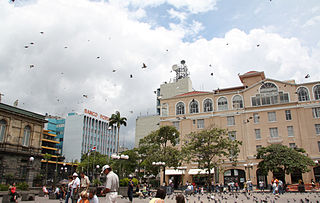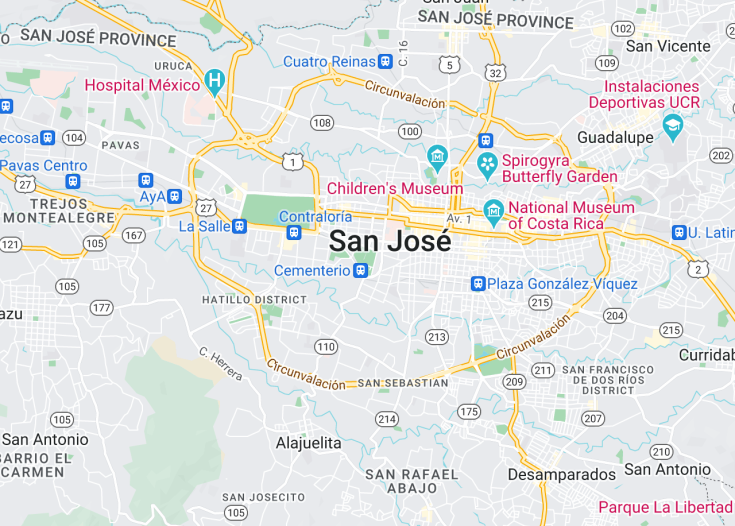San José, the vibrant capital of Costa Rica, serves not only as the hub of national governance and economics but also as a beacon of cultural history and diversity. This lively city, nestled in the heart of the Central Valley, is surrounded by lush green mountains and valleys. It boasts a pleasant climate throughout the year and offers a mix of historical architectures, such as the neoclassical National Theater, alongside modern amenities. Visitors can delve into numerous museums, parks, and markets that provide a deep dive into the local culture and lifestyle.
To make the most of your visit to San José, be sure to explore the city on foot or by using the affordable public transportation. It’s a fantastic way to discover hidden gems and interact with locals.
Consider visiting during the dry season from December to April. During this time, the climate is most favorable for exploring the city’s abundant outdoor attractions and vibrant street life.
Top things to do & see in San José
Select the following sights and activities to discover best tickets and tours available in San José.
San José: The Heartbeat of Costa Rica
| Country | Costa Rica |
| Time in San José | GMT-6 |
| Language spoken | Spanish |
| Population | 333,980 (World Population Review, 2021) |
| Currency | Costa Rican colón (₡ / CRC) |
| Airports | Juan Santamaría International Airport (10 mi / 16 km) |
San José, the vibrant capital of Costa Rica, pulsates with life amid its verdant tropical landscape. As a cultural, political, and economic hub, it showcases the essence of Costa Rican traditions interwoven with modern influences. The city’s rich history dates back to the 18th century when it emerged as an important settlement due to its fertile lands and accessible location. Today, San José stands as not only the administrative center but also a bastion for arts, cuisine, and education in Central America.
Historically, San José was not always the predominant city in Costa Rica. It rose to prominence in the mid-19th century, becoming the capital due to its strategic location at the center of the country, facilitating easier trade and communication networks across Costa Rica. This centralization helped shape it into the multicultural metropolis that draws tourists and locals alike to its numerous museums, theaters, and historical buildings, such as the National Theatre of Costa Rica, which is a masterpiece of classical architecture.
The city’s charming avenues and vibrant markets like the Mercado Central provide a glimpse into everyday life in San José. Here, one can explore an array of local crafts, fresh produce, and traditional dishes that reflect the diverse culinary heritage of Costa Rica. The city also serves as a pivotal starting point for eco-tourists venturing into the nation’s renowned national parks and protected areas, which showcase an astonishing array of biodiversity.
From a leisure perspective, San José offers plentiful parks and public squares that facilitate social gatherings and community events, highlighting the locals’ laid-back yet joyous lifestyle. These green spaces not only add to the city’s charm but also play a critical role in the social and environmental fabric of the urban landscape.
Where is San José?
Located in the central part of Costa Rica, San José lies in a fertile valley surrounded by mountains and coffee plantations.
Distances:
| Route | Distance by car | Time by car |
|---|---|---|
| Alajuela to San José | 12 mi / 19 km | 30 min |
| Heredia to San José | 7 mi / 11 km | 20 min |
| Cartago to San José | 15 mi / 24 km | 35 min |
What is San José famous for?
San José is renowned for its rich cultural scene, historic architecture, and active nightlife, making it a hub of Costa Rican heritage and contemporary lifestyle.
History
Pre-Columbian Times – Before 1502
Before the Spanish arrival, the area now known as San José was inhabited by indigenous people, primarily belonging to the Huetar kingdom. These indigenous groups lived in scattered villages throughout the Central Valley, thriving on agriculture, hunting, and fishing.
Spanish Colonization – 1502-1821
San José was discovered by Europeans when Christopher Columbus reached the coast of Costa Rica during his fourth voyage in 1502. The actual city of San José was not established until 1738, beginning as a small village. It became more prominent when tobacco growers and other agricultural settlers moved into the area. In 1821, Costa Rica declared its independence from Spain, marking the end of the colonial era.
The Building of a Nation – 1821-1900
After independence, San José became the capital of Costa Rica in 1823, due to its strategic location in the center of the country. The city grew as the political and economic heart of the nation. The late 19th century saw the introduction of coffee cultivation, which significantly boosted the economy and influenced the architectural development of the city.
20th Century Growth – 1900-Present
The 20th century was a period of rapid growth for San José. It modernized through the introduction of electricity, the construction of the railroad to the Atlantic coast, and the establishment of the University of Costa Rica. The city expanded its infrastructure and public services, becoming a central hub for education and culture in Central America. Today, San José stands as a vibrant city noted for its historical landmarks, museums, and as the political and economic center of the country.
Visit San José
What to see and do in San José, Costa Rica
San José, the capital city of Costa Rica, offers a variety of attractions and activities for visitors. Explore the rich cultural heritage of the city at the National Museum of Costa Rica, which provides insights into the country’s history from pre-Columbian times to the present. Art enthusiasts will enjoy the Costa Rican Art Museum, housed in a beautiful old airport terminal. For a taste of local life, visit the Central Market, where you can find everything from handicrafts to local cuisine. Don’t miss a walk around the bustling Avenida Central, a pedestrian-only street filled with shops and street performers.
- National Museum of Costa Rica
- Costa Rican Art Museum
- Central Market
- Avenida Central
Festivals and Events in San José
San José hosts several cultural events throughout the year, enhancing its appeal as a vibrant urban center. Notable events include the FIA (International Arts Festival) in April, which showcases arts and performances from around the world. In September, the city celebrates Independence Day with festive parades and colorful ceremonies. The “Festival de la Luz,” a spectacular light festival in December, transforms the city into a dazzling display of lights and floats, drawing large crowds and creating a festive atmosphere.
Best time to visit San José
The ideal time to visit San José is during the dry season from December to April. This period offers sunny days and a vibrant atmosphere, perfect for exploring the city and participating in outdoor events. The weather during these months is generally pleasant, making it easier to enjoy all that San José has to offer.
Is San José worth visiting?
San José is certainly worth visiting for its unique blend of cultural richness, historical significance, and vibrant urban life. The city offers a gateway to Costa Rica’s renowned natural beauty while providing its own array of attractions, from museums and historical buildings to lively markets and festivals. Whether you’re a history buff, cultural enthusiast, or simply looking to experience the Tico way of life, San José provides an enriching and enjoyable experience.










